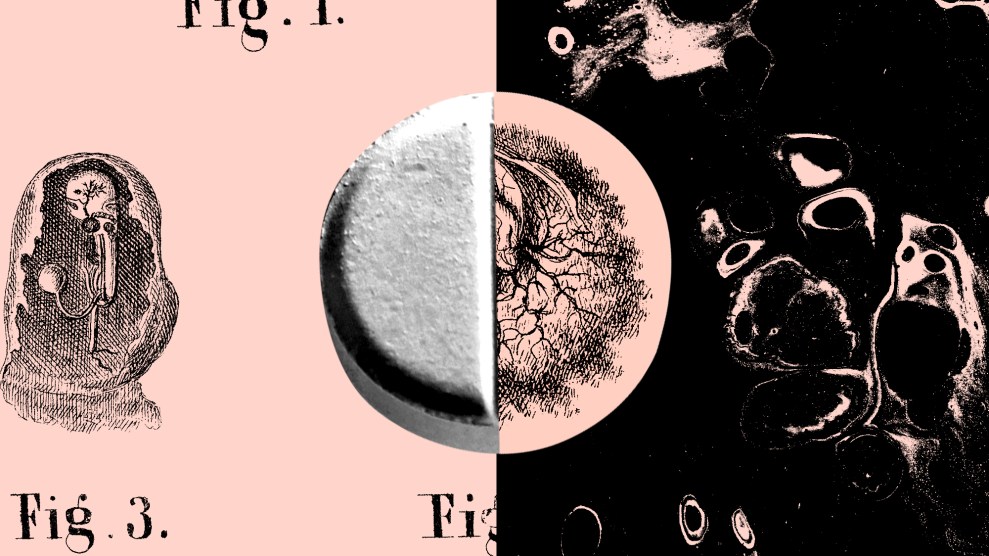
Mother Jones; Getty
On Friday night, Judge Matthew Kacsmaryk rolled back the FDA’s authorization of mifepristone, the first drug in the standard two-part medication abortion protocol. The ruling is an unprecedented judicial act: A federal court overruling the long-standing scientific judgment of the FDA. As if to underscore the dangerous absurdity of the situation, Kacsmaryk quickly abandons science in his opinion, relying on suspect research and presenting a warped view of abortion and pregnancy that begins to depart from reality on page 2.
Kacsmaryk’s opinion is suffused with illogical thinking, bizarre word games, ignored context, and unscientific findings. Here are over a half dozen times he flies in the face of reality.
Kacsmaryk Fallacy #1: “Unborn humans”
Throughout his opinion, Kacsmaryk uses the phrases “unborn child” or “unborn human,” adopting the language of the anti-abortion movement over the scientific terminology. But, in a footnote on page 2, he claims he is doing so in the name of science. “Jurists often use the word ‘fetus’ to inaccurately identify unborn humans in unscientific ways,” Kacsmaryk writes. “The word ‘fetus’ refers to a specific gestational stage of development, as opposed to the zygote, blastocyst, or embryo stages.” Therefore, for scientific accuracy, he says he prefers to us the inclusive terms of “unborn child” or “unborn human.”
But with a little googling, I can help Kacsmaryk get the science right. A zygote will almost never be aborted via a medication abortion because it will have become a blastocyst by the time a person realizes they are pregnant and can take steps to obtain an abortion, according to the Mayo Clinic. Likewise, the subsequent blastocyst stage is very short. By the fifth week of pregnancy—one week after a missed period—people seeking an abortion are seeking to expel an embryo. While it’s possible to obtain and take mifepristone before the fifth week, and thus abort a blastocyst, it rarely happens. The FDA has approved medication abortion up to 10 weeks of pregnancy. An embryo becomes a fetus at the start of week 11. Kacsmaryk might argue that some pregnant people are prescribed mifepristone beyond the 10th week, but that is not what the FDA authorized. Therefore, Kacsmaryk can safely use the term embryo throughout his opinion to scientifically and accurately describe the gestational stage under which medication abortions are approved by the FDA and under which the vast majority of medication abortions take place.
Of course, “science” cannot explain why Kacsmaryk’s opinion calls doctors who proscribe these pills “abortionists.” I suspect science is not the actual reason for his chosen terminology.
Kacsmaryk Fallacy #2: Side effects
One of the most outlandish parts of Kacsmaryk’s ruling is that he didn’t throw the whole case out for lack of standing—the procedural hurdle in which judges make sure a plaintiff actually suffers an injury that can be remedied by the lawsuit. Instead, he grants doctors and their anti-abortion associations the right to bring this suit, in part, on the contention that mifepristone’s side effects are so terrible that the plaintiff doctors are placed in the difficult position of having to deal with the gruesome fallout. “The associations’ members have standing because they allege adverse events from chemical abortion drugs can overwhelm the medical system and place ‘enormous pressure and stress’ on doctors during emergencies and complications,” he writes. “These emergencies ‘consume crucial limited resources, including blood for transfusions, physician time and attention, space in hospital and medical centers, and other equipment and medicines.'”
This is a good time to share the facts about the safety of medication abortions. The FDA estimates the efficacy rate is 99.6 percent. The risk of serious complication is 0.4 percent, and the mortality rate is .00064 percent. As the government pointed out in one brief, the FDA believes “the rates of serious adverse events are low: transfusions are 0-0.1 percent, sepsis is less than 0.01 percent, hospitalization related to medical abortion [i.e., medication-induced abortion] is 0-0.7 percent, and hemorrhage is 0.1 percent.” Yet these the anti-abortion groups behind the suit claim that mifepristone-related problems are overwhelming the medical system.
If the medical system is that fragile, let me tell you about something else that may overwhelm it: pregnancy and childbirth, especially from an increased number of people forced to endure them when they don’t want to. Even a complication-free pregnancy and delivery requires significant medical resources, from routine prenatal visits to labor itself, which generally results in a few days in the hospital. And after the birth, the medical system must take on the care of a new person—not just immediately, but for their entire life. The dangers of pregnancy far outweigh those of medication abortion. As the government’s brief states, “The risk of childbirth related death was therefore approximately 14 times higher than the rate associated with legal abortion.”
So, scientifically speaking, if Kacsmaryk is sparing doctors and patients a small chance of serious complication during an abortion, he’s putting them at a much greater risk to confront harms resulting from pregnancy, and creating a need to provide care for any child that results.
Kacsmaryk Fallacy #3: Post-abortion trauma
Perhaps the most offensive part of Kacsmaryk’s opinion is its paternalism. He grants the anti-abortion groups standing in part on the premise that people who have obtained abortions are too damaged by the experience to be capable of bringing a lawsuit themselves.
To argue so, Kacsmaryk cites at least two studies by anti-abortion groups to allege medication abortion is deeply physically and psychologically damaging. Using the literature of the anti-abortion movement, including a debunked report from an anti-choice researcher, Kacsmaryk states that “adverse abortion experiences that are often deeply traumatizing pose a hindrance to a woman’s ability to bring suit.”
In fact, reputable studies suggest the opposite. I’d like to introduce Kacsmaryk to the findings of the American Psychological Association, the largest group of psychologists in the United States:
More than 50 years of international psychological research shows that having an abortion is not linked to mental health problems, but restricting access to safe, legal abortions does cause harm. Research shows people who are denied abortions have worse physical and mental health, as well as worse economic outcomes than those who seek and receive them.
Kacsmaryk Fallacy #4: Pregnancy can’t be considered an “illness”
Kacsmaryk says that “pregnancy is not an ‘illness.'” To which I, the mother of a toddler, say, have you tried the first trimester?
Kacsmaryk claims that, technically, pregnancy is not an illness and therefore the FDA erred in approving mifepristone, in small part, under a regulation for drugs that treat “serious or life-threatening illnesses.” And not only is it not an illness, he argues, neither is pregnancy serious or life-threatening. In response, one might point to the US’ rising maternal mortality rates among Black and brown communities, or to anyone with an underlying condition that makes pregnancy high-risk. But Kacsmaryk—who, remember, is a juris doctor, not an actual doctor—disagrees: “True, complications can arise during pregnancy, and said complications can be serious or life-threatening. But that does not make pregnancy itself an illness.”
Even for those who have healthy pregnancies, the process forces the body to a maximum level of human endurance. “To think about pregnancy in the same terms that we think about Tour de France cyclists and triathletes makes you realize how incredibly demanding pregnancy is on the body,” explains a scientist who helped conduct a 2019 study comparing pregnancy to endurance athletic events.
Kacsmaryk may be right that pregnancy isn’t strictly considered as an illness. But who cares? It’s an absurd reading of the FDA’s authority to assume that the agency can approve medicine to treat life-threatening illnesses but not other life-threatening conditions. Why would an agency or Congress create such a distinction? That’s probably why the government argued that the FDA’s authority is for both “serious or life threatening conditions, as well as to illnesses or diseases.” But Kacsmaryk, ever the scientist, isn’t having it.
Kacsmaryk Fallacy #5: Mifepristone has no “therapeutic benefit”
Kacsmaryk contends that because pregnancy is not an illness, abortion drugs cannot be therapeutic. Is that science? I think it’s a distinction without a difference. Kacsmaryk tries to support his conclusion by citing more anti-abortion literature claiming medication abortions lead to terrible physical and psychological consequences. Any study that claims, as does one that Kascmaryk cites to make this point, that “eighty-three percent of women report that chemical abortion ‘changed’ them—and seventy-seven percent of those women reported a negative change,” is, scientifically speaking, bullshit.
Kacsmaryk Fallacy #6: Medical abortions and bleeding
Kacsmaryk opines that “bleeding from a chemical abortion, unlike surgical abortion, can last up to several weeks.” This is true! He got one right! But I just want to point out that something else that causes bleeding for several weeks: giving birth. So his opinion sparing women a few weeks of bleeding in the first trimester isn’t doing anyone any favors in the bleeding department.
Kacsmaryk Fallacy #7: Blocking abortion makes women safer
The anti-abortion crusade has anointed itself the savior of women. This lawsuit offers a clear example: the plaintiffs and judge seem to believe that people who have had abortions are so damaged and distraught they can’t file a lawsuit, and that, even though majorities support access to abortion, the most common form of the procedure must be stripped from all pregnant people in the United States. Not only can pregnant people not file a lawsuit, they also don’t know what’s best for them.
Scientifically speaking, this decision and the movement behind it will make pregnancy and abortion more dangerous. Kacsmaryk’s opinion refers to medical care and maternity care “deserts,” areas where he worries treating abortion drugs’ supposed adverse effects would be challenging. What he doesn’t mention is that the right-wing and anti-abortion movements—both of which Kacsmaryk is a longtime member—have helped create these deserts.
The expansion of Medicaid under the Affordable Care Act, for example, created a lifeline to struggling rural hospitals. But several GOP-controlled states declined to expand Medicaid, and as a result, their rural hospitals were more likely to close than those in states that did, creating care deserts.
Maternity care deserts are themselves a serious problem, one that is worsening as birth wards at rural hospitals around the country are closing, sometimes due to anti-abortion policies. A Bonner County, Idaho, hospital, for example, said that it would close its maternity ward because, due the state’s “legal and political climate, highly respected, talented physicians are leaving. In addition, the Idaho Legislature continues to introduce and pass bills that criminalize physicians for medical care nationally recognized as the standard of care.” (After the Supreme Court overturned Roe v. Wade, Idaho banned abortions with few exceptions.)
Throughout his opinion, Kacsmaryk complains that doctors prescribe mifepristone without first performing a sonogram to determine how far the pregnancy has progressed, or to rule out an ectopic pregnancy. Well, you know what would make doing that easier? More access to doctors and clinics. Of course, not only do anti-abortion laws chase doctors out of the states that enact them, those same states have also spent years trying to shut down abortion clinics that can also provide critical care like contraception, cancer screenings, and sonograms. The overturning of Roe is likely to further limit access to the very care Kacsmaryk says women should be getting.
Without mifepristone, some doctors may be forced to only prescribe the abortion medication misoprostol, the second drug in the two-step regimen, and which can induce an abortion without mifepristone. The biggest downside is that it causes more cramping and bleeding than when combined with mifepristone.
Kacsmaryk says abortion medication is too dangerous, but he doesn’t admit one reason it has become so popular is that anti-abortion policies have taken away other options, including contraception and surgical abortion. It’s not hard to imagine an upcoming lawsuit seeking to ban a misoprostol-only protocol, based on the fact that it’s more dangerous or painful than the two-drug combo, that makes no acknowledgement of how doctors and patients were put in that position in the first place.
In the end, this opinion is not about protecting patients or doctors. The science proves it.













